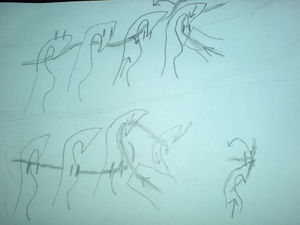Knitting Machine
Basics
Knitting machines were developed throughout the 20th century in order to speed up what was otherwise a very time-consuming process for producing clothing. Initially they improved upon an operation ostentibly involving two knitting needles, by using moving carriages past a row of small moveable hooks, and then allowed for those pins to be selected by a computer program. Each step represented an order of magnitude decrease in human labour-time needed to make a given garment.
Research
Linear Knitting Machines
These are best suited for producing garments with large surface areas, especially with chiefly rectangular surfaces. For example, scarves are easily made in one job, sections can be sewn together to produce sweaters, or complex digital patterns can even produce one such garment in a single run (see below).
Thanks to the efforts of Knitic, who were hacking on old floppy-disc-controlled Brother linear knitting machines, some free software was created to enable general programming of this type of machine. Since then, the OpenKnit project has gone ahead and created a completely open hardware design for a mostly-3D-printable machine.
Circular Knitting Machines
These are more appropriate for producing garments that involve tube sections where a seam sewn along its length can cause discomfort, e.g. socks, stockings, winter hats and sleeves for other garments. Their utility, while arguably narrow, is very powerful since they can produce socks in minutes with a skilled operator, and socks/hosiery are generally the type of garments that wear out fastest.
Their theory of operation is relatively simple, but as far as I know there are no CNC designs in the public domain, although there is a lot of information to search through and many images of actual machines with long-expired patents.
While the 100-year-old steel machines look like they could be very difficult to replicate in a basic fab-lab due to their intricate construction, the existence of more recent 'toy'/'hobby' versions, constructed with chunky plastic, seems to indicate that this could be possible on your average RepRap Prusa-Mendel, so long as small size is not an initial requirement.
As far as I have seen from these modern plastic versions, their hooks are not designed to be locked in place (as in the 8.5minute sock video, when turning a heel), so some modification may be needed to add that functionality. After that, it may be possible to add digital control of individual hooks as with the above linear machines. In the near term, it would be very helpful to see the internals of one of these machines (preferably a high-end one), so am appealing for anyone out there to keep an eye out for any broken-down Addi Express machines, so that we can avoid 'reinventing the wheel' from scratch. - Andy D
Needles
plastic needles
https://www.amazon.com/dp/B0074O9U3S?ref_=pfb_63ca9g6b79ba0g0c7151il8603cd
Addi Express
Product Ecology
| From | Uses | Creates | Enables |
|---|---|---|---|
Components
|
|
|
State of Open Source Availability
The linear machine went closed source after some early development. there is a github page but the design is frozen in beta mode. https://github.com/g3rard/OpenKnit
It seems linear machines are usually used for intricate designs in the fabric, but also to change the weave on the fly. I think the complexity of the machine vs the limited utility make circular machines more favorable.
Machines that make denim are a whole different beast https://www.youtube.com/watch?v=i_G0YtXeLlY
It appears most industrial machines that are used to make larger pieces of fabric use circular machines. https://www.youtube.com/watch?v=aHDY-QxANVk https://www.youtube.com/watch?v=simzE7S-8o8
The CircularKnitic machine is a small format machine sized to make sock diameter output. It uses a simple 1 spool of thread at a time feed. It also uses the same style needles typically used in hobby linear machines. There are a handful of hobby circular machines for sale that are in this size category. https://github.com/var-mar/circular_knitic https://www.youtube.com/watch?v=Ri9l0QdsUXA
I dont know anything about the different types of weaving/knitting but the industrial circular machines are fed from many spools at the same time. They also use much smaller gauged needles for a finer weave. Later the circle of fabric is typically cut lengthwise to be used as a simple flat piece to make shirts etc.
I think the best short term path forward is to increase the size of the CircularKnitic. Perhaps sized to be a diameter able to be mounted on a piece of standard ply wood. If all goes well, it should create large pieces of fabric at a slow speed. I think the utility of a full sized piece of fabric is appealing for a variety of uses. Perhaps later, the speed could be increased, then maybe refine the design for smaller thread and finer gauge needles. To change the style of weaving/knitting and increase the number of spools fed into the machine would be much more of a challenge.
Videos
Internal Links
Industry Standard
Double Knit
- https://www.seamwork.com/issues/2015/01/working-with-double-knit
- https://oliverands.com/community/blog/2010/12/some-knit-fabric-basics.html
External Links
- OpenKnit devolves to proprietary Kniterate - at Haxlr8r, Kickstarter success - [1]
- CircularKnitic Project
- Instructable
- github
- depricated knitic Knitic - Open hardware knitting machine
- Valentina Open source cross-platform patternmaking program which allows designers to create & model patterns of clothing
- OpenKnit Project
- Andre Bandarra - https://www.youtube.com/watch?v=yM4Rb0DTyKU

